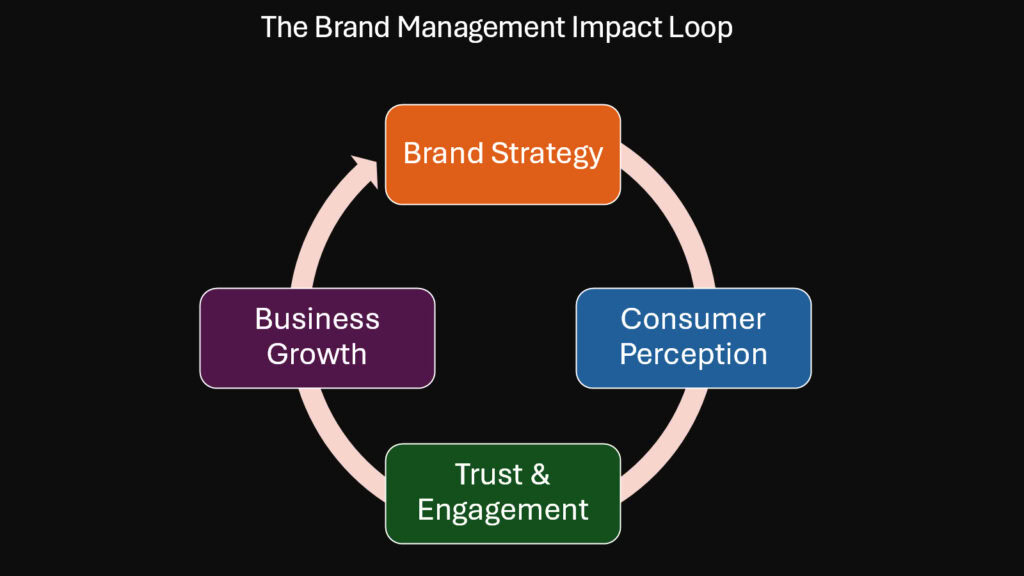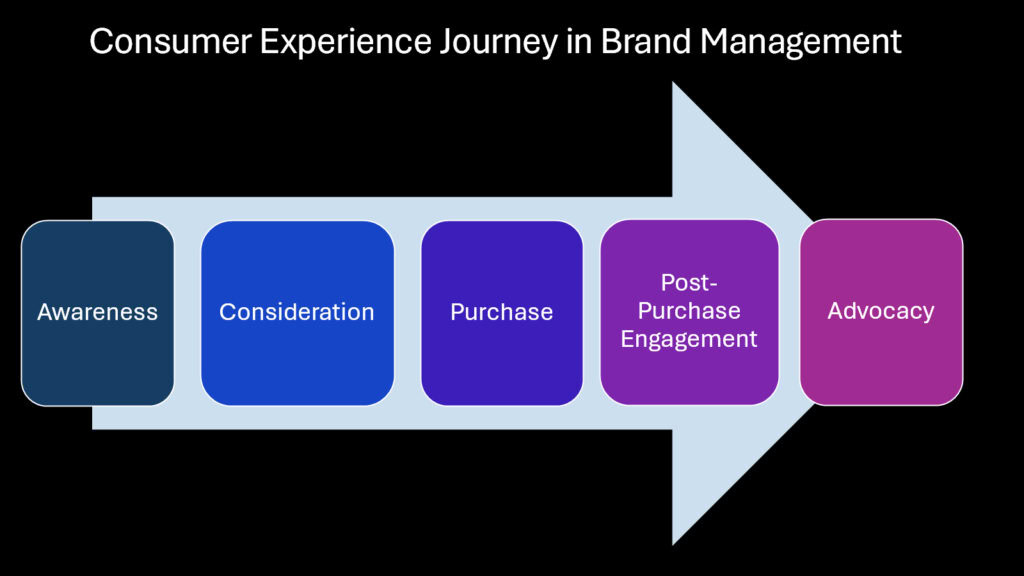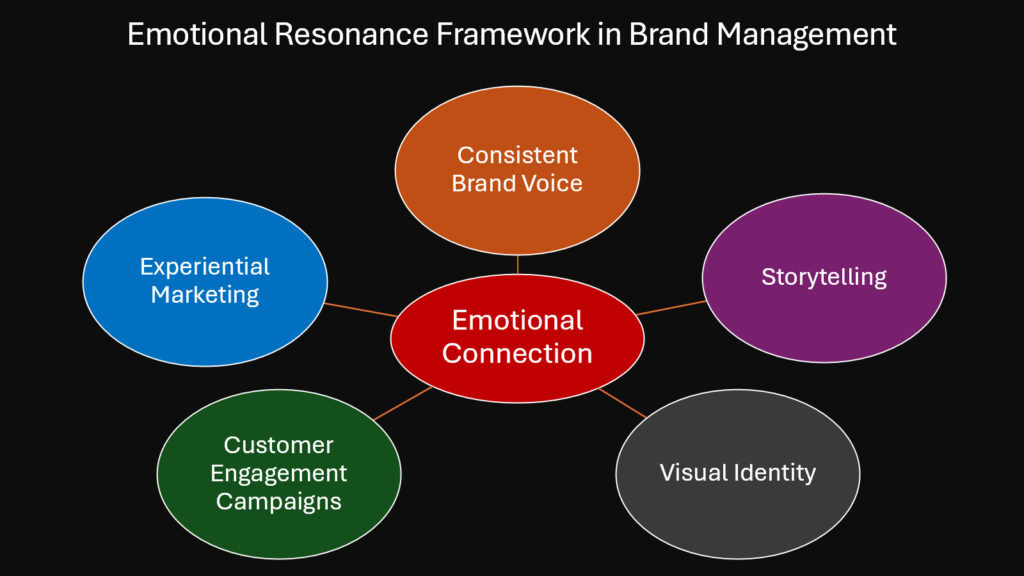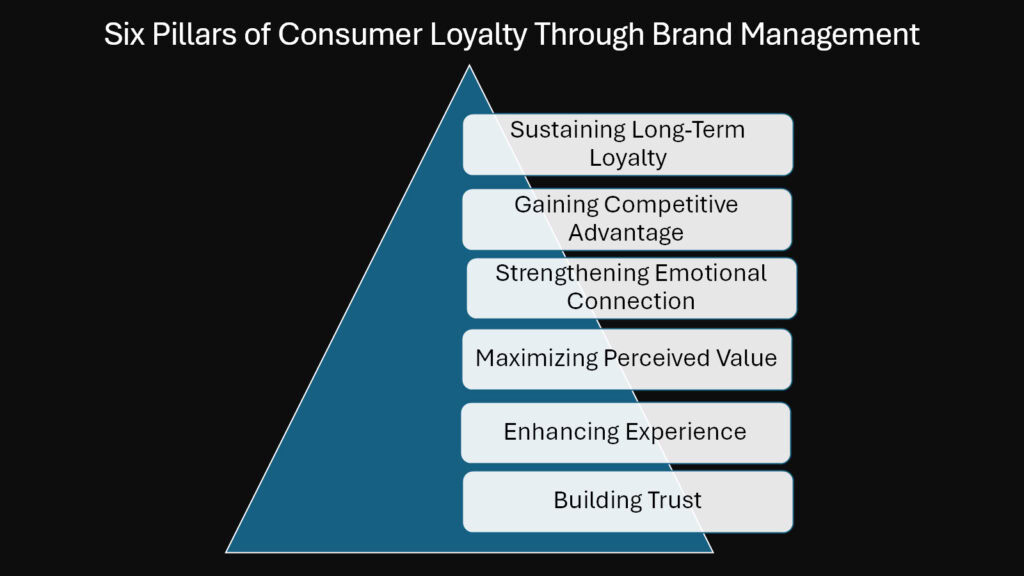Table of Contents
Introduction to Brand Management: Unlocking Consumer Loyalty

The marketplace whispers a truth that every business executive knows but few master. Consumer loyalty no longer stems from mere product superiority or competitive pricing. It emerges from something deeper, something more deliberate. Brand Management has evolved into the cornerstone marketing function that shapes how consumers perceive, trust, and ultimately commit to businesses over time.
Consider the coffee you bought this morning. Was it truly superior to dozens of alternatives, or did you choose it because the brand had earned your trust through years of consistent experience? This simple decision reflects the profound influence that Brand Management wields over consumer behavior. As markets become saturated and product differentiation narrows, the ability to manage brand perception determines which companies thrive and which fade into obscurity.
Brand Management operates at the intersection of psychology and commerce. It transforms functional transactions into meaningful relationships. When executed strategically, it creates an invisible architecture that guides consumer choices, builds lasting trust, and generates loyalty that withstands competitive pressures. Modern consumers navigate an overwhelming landscape of choices, encountering thousands of brand messages daily yet remembering only a fraction. In this environment, Brand Management becomes the critical differentiator that cuts through noise by establishing clear positioning and creating experiences that transform customers into advocates.
This article explores six powerful ways that Brand Management cultivates consumer loyalty. From building foundational trust to creating emotional connections that transcend rational decision-making, these approaches demonstrate how strategic brand stewardship transforms casual buyers into lifelong customers.
Table 1: Brand Management Integration With Core Marketing Functions
| Marketing Functions | Relationship to Brand Management |
|---|---|
| Market Research | Brand Management relies on market research to understand consumer perceptions, identify positioning opportunities, and track brand health metrics that inform strategic decisions |
| Consumer Insights | Brand Management translates consumer insights into actionable brand attributes, messaging frameworks, and experience designs that resonate with target audiences |
| Product & Service Positioning | Brand Management defines how products occupy distinct space in consumer minds through positioning strategies that highlight unique value propositions |
| Pricing Strategy | Brand Management influences pricing decisions by establishing perceived value that justifies premium pricing or supports volume-based approaches |
| Promotion & Advertising | Brand Management provides the strategic foundation for promotional activities, ensuring all communications reinforce core brand identity and promise |
| Content Marketing & Storytelling | Brand Management shapes narrative frameworks that guide content creation, ensuring stories align with brand values and strengthen emotional connections |
| Digital Marketing & Performance Analytics | Brand Management sets brand guidelines for digital channels while using analytics to measure brand perception and optimize consumer engagement |
| Sales Enablement & Lead Generation | Brand Management creates tools and messaging that empower sales teams to communicate value propositions consistently across customer touchpoints |
1. Leveraging Brand Management to Build Strong Consumer Trust
Trust forms the bedrock upon which lasting consumer relationships stand. Without it, transactions remain vulnerable to price competition and easily disrupted by competitors. Brand Management transforms this dynamic by systematically building psychological reliability that converts skeptical prospects into confident advocates.
Trust-Building Theory reveals that consumers evaluate brands through multiple lenses simultaneously. They assess competence by observing whether brands deliver on promises consistently. They gauge benevolence by determining whether brands prioritize customer welfare over short-term profits. They measure integrity by tracking alignment between stated values and actual behavior.
Patagonia demonstrates trust-based Brand Management through radical transparency, openly sharing supply chain practices and environmental impacts even when unflattering. When Patagonia encourages customers to repair rather than replace products, it signals benevolence that deepens emotional bonds. Toyota rebuilt trust after quality concerns by communicating openly about corrective measures while implementing rigorous controls, demonstrating that trust stems from consistent behavior rather than marketing promises alone.
The mechanisms through which Brand Management builds trust extend beyond crisis management. Consistent visual identity creates familiarity that reduces cognitive effort. Predictable product quality eliminates uncertainty about purchase outcomes. Responsive customer service demonstrates commitment to consumer welfare. Together, these elements construct a trust architecture that makes choosing the brand feel safe and rational.
Research indicates that trust reduces perceived risk in purchase decisions. When consumers trust a brand, they require less information before buying, show greater forgiveness for occasional mistakes, and pay premium prices willingly. Brand Management also leverages trust to facilitate expansion into new categories. Amazon built trust through reliable e-commerce operations, then extended that goodwill into cloud computing and streaming entertainment.
Table 2: Trust-Building Elements in Brand Management Strategy
| Trust Component | Brand Management Application |
|---|---|
| Competence Trust | Delivering consistent product quality, meeting deadlines, and ensuring reliable service across all customer interactions builds confidence in brand capabilities |
| Benevolence Trust | Demonstrating customer-first policies, ethical business practices, and genuine concern for consumer welfare signals that the brand prioritizes relationship over transaction |
| Integrity Trust | Aligning brand actions with stated values, maintaining transparency in operations, and honoring commitments establishes moral reliability |
| Predictability Trust | Creating consistent brand experiences across touchpoints, maintaining visual identity standards, and delivering expected quality reduces uncertainty |
| Communication Trust | Providing honest product information, acknowledging limitations, and responding authentically to feedback builds credibility through transparency |
| Recovery Trust | Handling complaints effectively, taking responsibility for failures, and implementing visible improvements demonstrates accountability that strengthens relationships |
| Third-Party Trust | Earning certifications, securing positive reviews, and building partnerships with respected organizations provides external validation of brand claims |
| Temporal Trust | Maintaining consistency over time, surviving market challenges, and demonstrating longevity signals stability that reduces perceived risk |
2. Enhancing Consumer Experience Through Effective Brand Management

Experience shapes perception more powerfully than advertising ever could. Consumers judge brands not by what companies say but by how interactions feel across the entire journey. Brand Management transforms disconnected touchpoints into orchestrated experiences that build loyalty through cumulative positive impressions.
Apple demonstrates how Brand Management elevates experience to competitive advantage. Retail stores feature minimalist design that reduces cognitive load and focuses attention on products. Employees receive training emphasizing empathy over sales tactics. Product packaging delivers tactile satisfaction that extends the pleasure of purchase. This experiential approach extends into digital realms where user interfaces prioritize intuitive interaction over feature density.
Multi-sensory branding represents another dimension of experience management. Starbucks carefully designs its stores to engage multiple senses simultaneously. The aroma of fresh coffee creates olfactory associations. Comfortable seating and warm lighting establish environments that invite lingering. The sound of espresso machines and background music creates auditory signatures that signal quality and craft.
Personalization has emerged as a critical experience enhancement tool. Netflix curates content recommendations that feel personally relevant. Spotify creates custom playlists that introduce new music while honoring established tastes. These personalized experiences make consumers feel understood, strengthening emotional bonds with brands.
Consistency across channels represents perhaps the most challenging aspect of experience management. Consumers expect seamless transitions between online and offline interactions. Brand Management ensures that digital experiences reflect the same values and quality standards as physical touchpoints, eliminating friction and reinforcing brand identity regardless of interaction method.
Table 3: Consumer Journey Enhancement Through Brand Management
| Journey Stage | Brand Management Enhancement Strategy |
|---|---|
| Awareness | Creating distinctive brand identity through consistent visual elements, memorable messaging, and strategic presence in channels where target consumers naturally gather |
| Consideration | Providing comprehensive information, authentic testimonials, and comparison tools that help consumers evaluate options while highlighting brand differentiation |
| Purchase | Streamlining transaction processes, offering multiple payment options, and ensuring that buying feels effortless while reinforcing the wisdom of the choice |
| Onboarding | Delivering clear setup instructions, welcome communications that express appreciation, and initial support that ensures successful product adoption |
| Usage | Providing ongoing education, tips for maximizing value, and proactive outreach that demonstrates continued investment in customer success |
| Support | Offering responsive service across preferred channels, empowering representatives to solve problems creatively, and treating issues as opportunities to exceed expectations |
| Retention | Implementing loyalty rewards, exclusive access to new offerings, and recognition programs that acknowledge long-term relationships |
| Advocacy | Facilitating easy sharing, creating referral incentives, and building communities where satisfied customers connect with prospects and each other |
3. Applying Brand Management to Maximize Perceived Value
Value exists primarily in consumer minds rather than in objective product features. Two nearly identical offerings can command vastly different prices based solely on how Brand Management shapes perception. Understanding and leveraging this psychological reality separates market leaders from commodity competitors.
Value Perception Theory illuminates how consumers assess worth through multiple dimensions simultaneously. Functional value derives from product performance. Economic value reflects financial sacrifice relative to benefits. Social value stems from how purchases affect status and group belonging. Emotional value emerges from feelings that products generate.
Rolex manages perceived value across multiple dimensions. While the watches deliver functional value through precision engineering, competitors offer comparable technical performance at fraction of the price. Rolex’s premium pricing stems from masterful management of social and emotional value. The brand associates itself with achievement and success through carefully curated ambassadors. Ownership signals status, delivering social value that extends beyond timekeeping.
IKEA demonstrates value perception management from the opposite direction. The Swedish furniture retailer positions itself around economic and functional value while maintaining emotional appeal. Brand Management emphasizes democratizing design, making stylish furniture accessible to middle-class consumers. The brand story frames affordable pricing as mission-driven rather than quality compromise.
Quality signals play crucial roles in shaping perceived value. Premium materials, sophisticated packaging, higher pricing, and selective distribution all signal superior quality. Even when actual quality differences are minimal, these signals influence perception powerfully. Brand storytelling amplifies perceived value by creating meaning beyond functionality. TOMS shoes built perceived value through its one-for-one donation model, transforming purchases into meaningful acts that justified higher costs.
Table 4: Value Dimension Management Framework
| Value Dimension | Brand Management Approach |
|---|---|
| Functional Value | Emphasizing product features, performance specifications, durability, and practical benefits that solve consumer problems effectively |
| Economic Value | Communicating cost efficiency, long-term savings, total ownership costs, and financial benefits that justify price through rational calculation |
| Social Value | Building associations with desirable groups, status symbols, and identity expressions that make purchases signal belonging or aspiration |
| Emotional Value | Creating feelings of joy, confidence, security, or excitement through brand interactions that generate psychological rewards |
| Episodic Value | Crafting memorable experiences, distinctive moments, and shareable events that become stories consumers want to remember and retell |
| Ethical Value | Demonstrating social responsibility, environmental stewardship, and moral alignment that lets consumers express values through purchases |
| Aesthetic Value | Delivering beauty, style, and sensory pleasure through design excellence that makes products desirable beyond functional utility |
| Convenience Value | Reducing effort, saving time, and eliminating friction throughout the purchase and usage journey to make brand choices easier |
4. Strengthening Emotional Connections Through Brand Management

Logic opens minds, but emotion opens wallets. Neuroscience research reveals that emotional centers in the brain activate before rational analysis during decision-making. Brand Management that recognizes this reality builds loyalty through emotional resonance rather than feature lists alone.
Emotional connections transform brands from vendors into relationships. Consumers develop feelings toward brands similar to those they hold for people. They experience betrayal when brands disappoint, joy when brands surprise them positively, and loss when favorite products disappear.
Nike exemplifies emotional Brand Management through its association with personal achievement and determination. The brand rarely focuses marketing on shoe technology. Instead, it tells stories of overcoming obstacles and pushing limits. The famous “Just Do It” tagline captures emotional aspiration rather than product attributes. When Nike stood behind Colin Kaepernick despite controversy, it reinforced its positioning around courage and conviction.
Coca-Cola has built perhaps the world’s most recognized brand primarily through emotional association. The beverage differs little from competitors in blind taste tests. Coca-Cola’s dominance stems from decades of Brand Management linking the product with happiness and togetherness. Holiday advertising featuring families gathering creates emotional memories that consumers associate with the brand.
Storytelling represents the primary vehicle through which Brand Management builds emotional connections. Compelling narratives engage consumers by presenting relatable characters and meaningful conflicts. Airbnb tells stories of belonging anywhere, transforming lodging transactions into adventures about human connection across cultures.
Brand Management also cultivates emotional connections through community building. Harley-Davidson transformed motorcycle ownership into lifestyle identity. The brand facilitates owner groups and rallies that create bonds among customers. These communities generate emotional attachment that extends beyond the product.
Table 5: Emotional Connection Building Tactics
| Emotional Strategy | Implementation Through Brand Management |
|---|---|
| Shared Values | Identifying core beliefs that resonate with target consumers and demonstrating authentic commitment to those principles through actions not just messaging |
| Aspiration Alignment | Positioning the brand as partner in achieving consumer dreams, goals, and self-improvement ambitions that matter deeply to identity formation |
| Nostalgia Activation | Evoking positive memories from the past through imagery, music, and references that create comfort while associating brand with cherished experiences |
| Purpose Beyond Profit | Articulating meaningful missions that transcend commercial objectives and inviting consumers to participate in causes larger than transactions |
| Belonging Creation | Building communities, exclusive groups, and shared identities that make brand ownership signal membership in desirable tribes |
| Surprise and Delight | Exceeding expectations through unexpected gestures, gifts, and experiences that generate positive emotional spikes consumers remember |
| Empathy Demonstration | Showing understanding of consumer challenges, frustrations, and desires through communications and solutions that feel personally relevant |
| Celebration Participation | Associating brand presence with life milestones, achievements, and joyful moments that create positive emotional anchoring |
5. Using Brand Management to Gain Competitive Advantage
Markets reward differentiation more generously than excellence. A mediocre brand with distinctive positioning often outperforms superior products that fail to establish clear identity. Brand Management creates competitive advantage by helping organizations stake claim to unique market positions that competitors struggle to challenge.
Porter’s Generic Strategies framework illuminates how Brand Management supports competitive positioning through three fundamental approaches. Cost leadership focuses on delivering acceptable quality at lowest prices. Differentiation creates unique value that justifies premium pricing. Focus strategies target specific segments intensely rather than serving broad markets moderately.
Differentiation strategies rely heavily on Brand Management to justify premium pricing. Apple differentiates through integrated ecosystem design and user experience excellence. Brand Management communicates this differentiation through minimalist aesthetics and premium retail environments. Consumers pay more for Apple products partly because Brand Management has successfully positioned them as fundamentally different from commodity alternatives.
Tesla demonstrates differentiation through Brand Management that positions electric vehicles as technological innovation rather than environmental compromise. Traditional automakers framed electric cars primarily through environmental benefits. Tesla’s Brand Management emphasizes acceleration, technology leadership, and future orientation, attracting consumers who valued innovation and performance.
Focus strategies concentrate on serving specific segments exceptionally well. Lululemon targets affluent yoga enthusiasts with premium athletic wear. Brand Management creates community around fitness lifestyle rather than simply selling clothing. This focused Brand Management makes the brand essential to its target segment while remaining irrelevant to others.
First-mover advantages often prove temporary unless reinforced through Brand Management. Netflix pioneered streaming entertainment but faced competition from deep-pocketed rivals. The brand maintained advantage through continued innovation and Brand Management that positioned Netflix as entertainment leader rather than technology provider.
Table 6: Porter’s Generic Strategies and Brand Management Application
| Strategic Approach | Brand Management Execution |
|---|---|
| Cost Leadership Position | Communicating value proposition through consistent low-price messaging, operational transparency, and brand identity emphasizing accessibility without inferior quality implications |
| Broad Differentiation | Creating distinctive brand personality, premium positioning, and emotional connections that justify higher prices through perceived uniqueness across broad market segments |
| Focused Differentiation | Building intense brand loyalty within specific segments through specialized messaging, community cultivation, and exclusivity that makes brand essential to target consumers |
| Cost Focus | Serving price-sensitive segments efficiently while maintaining brand recognition that signals reliability without aspirational positioning that might alienate budget-conscious buyers |
| Hybrid Strategies | Balancing cost efficiency with selective differentiation through Brand Management that emphasizes smart value rather than cheap alternatives or pure luxury positioning |
| Geographic Focus | Adapting brand expressions to regional preferences while maintaining core identity elements that provide consistency and leverage global brand equity |
| Innovation Leadership | Positioning brand as forward-thinking pioneer through consistent emphasis on advancement, technology leadership, and change agency that attracts early adopters |
| Quality Leadership | Building brand reputation around superior craftsmanship, reliability, and excellence through consistent delivery and communications emphasizing standards and attention to detail |
6. Maintaining Long-Term Consumer Loyalty With Strategic Brand Management
Acquisition costs dwarf retention expenses, yet many organizations invest disproportionately in pursuing new customers while neglecting existing relationships. Strategic Brand Management recognizes that sustaining loyalty requires continuous attention, adaptation, and innovation that keeps brands relevant as markets and consumers evolve.
Loyalty programs represent obvious Brand Management tools for encouraging repeat purchases. Starbucks modernized the approach with its digital rewards system that gamifies consumption while gathering data for personalization. However, transactional loyalty differs from emotional commitment. True loyalty stems from Brand Management that builds connections transcending point accumulation. Amazon Prime exemplifies this deeper approach through subscription models that create committed relationship status.
Continuous feedback integration keeps brands aligned with evolving consumer needs. Brand Management must establish systems for gathering, analyzing, and acting upon customer input across multiple channels. Social media monitoring reveals emerging concerns before they escalate. Purchase pattern analysis identifies shifting preferences that require product or positioning adjustments.
The ability to evolve while maintaining core identity separates enduring brands from those that become irrelevant. IBM has transformed multiple times over its century-plus history, from office equipment to computer hardware to business services and cloud computing. Through each transformation, Brand Management maintained core positioning around business problem-solving and technological expertise.
Innovation keeps brands interesting and prevents commoditization. Brand Management must balance consistency with freshness. Limited edition offerings create excitement without requiring permanent line changes. Collaborations with other brands introduce novelty that attracts attention. Technology adoption shows contemporary relevance.
Crisis management capabilities determine whether brands sustain loyalty through inevitable challenges. Johnson & Johnson’s handling of Tylenol tampering incidents established gold standard crisis response. The company prioritized consumer safety over short-term profits, recalled products nationwide, and pioneered tamper-resistant packaging. This Brand Management approach during crisis actually strengthened loyalty.
Table 7: Long-Term Loyalty Maintenance Strategies
| Loyalty Dimension | Brand Management Approach |
|---|---|
| Rewards Systems | Designing programs that create genuine value beyond discounts, offering personalization and exclusive experiences that make participation feel privileged rather than transactional |
| Continuous Engagement | Maintaining communication cadence that provides value through content, tips, and entertainment rather than constant sales pitches that erode goodwill |
| Feedback Responsiveness | Demonstrating that customer input influences decisions through visible product improvements, policy changes, and acknowledgment of concerns |
| Proactive Evolution | Anticipating market changes and adapting brand expressions before becoming outdated while preserving core identity elements that provide stability |
| Community Building | Creating spaces for customers to connect with each other around shared interests, transforming individual relationships into social networks centered on brand |
| Consistent Excellence | Maintaining quality standards and experience delivery across all touchpoints over time to build reliability expectations that consumers depend upon |
| Value Demonstration | Continuously communicating benefits and celebrating customer success stories that remind consumers why they chose the brand originally |
| Surprise Elements | Periodically exceeding expectations through unexpected upgrades, gifts, or recognition that generates positive emotional spikes in otherwise routine relationships |
Conclusion: The Transformative Power of Brand Management on Consumer Loyalty

The marketplace has spoken its verdict. Brands that manage consumer perceptions strategically and authentically outperform competitors across virtually every business metric. Revenue grows more predictably. Profit margins expand through premium pricing power. Customer acquisition costs decline as advocacy replaces advertising.
The six approaches explored throughout this article illuminate how Brand Management transforms commercial relationships into something approaching human connection. Building trust establishes psychological safety that makes choosing the brand feel wise. Enhancing experiences creates cumulative positive impressions that become habitual preferences. Managing perceived value allows brands to command pricing that reflects emotional and social benefits beyond functional utility.
Emotional connections elevate brands from vendors to partners in consumer identity formation. Competitive advantage flows naturally from effective Brand Management because distinctive positioning becomes self-reinforcing. Strong brands attract better talent, secure favorable partnerships, and command attention that amplifies marketing efficiency.
Long-term loyalty requires continuous attention as markets evolve. Brand Management must balance consistency with adaptation, maintaining recognizable identity while demonstrating vitality and relevance. Business leaders often underestimate Brand Management’s strategic importance, viewing it as marketing tactics rather than core business function. This perspective misses the fundamental reality that brand equity often exceeds tangible asset value.
Implementation requires commitment extending beyond marketing departments. Brand Management succeeds when entire organizations embrace the brand promise and deliver it consistently. Operations must maintain quality standards. Customer service must embody brand values. Product development must extend brand positioning into tangible offerings.
The investment pays dividends across business 360°. During downturns, strong brands retain customers who view price as one factor among many. During growth periods, they capture disproportionate share by converting preference into purchase behavior. Through disruptions, they enjoy goodwill that provides time to adapt while competitors struggle with commodity status.
Table 8: Brand Management Impact on Business Outcomes
| Business Outcome | Brand Management Contribution |
|---|---|
| Revenue Growth | Loyal customers purchase more frequently, spend more per transaction, and remain active longer, creating predictable revenue streams that compound over time |
| Profit Margins | Strong brands command premium pricing that improves margins while reducing dependence on promotional discounting that erodes profitability |
| Customer Acquisition | Brand reputation reduces marketing costs as word-of-mouth advocacy and organic discovery replace paid advertising as primary acquisition channels |
| Market Valuation | Brand equity contributes significantly to enterprise value, often representing majority of market capitalization beyond tangible assets |
| Competitive Resilience | Established brand loyalty creates switching costs that protect market share during competitive attacks and economic downturns |
| Talent Attraction | Strong brands recruit and retain superior employees who seek affiliation with recognized leaders and share brand values |
| Partnership Leverage | Brand strength secures favorable terms with suppliers, distributors, and collaborators who value association with prestigious brands |
| Innovation Success | Trusted brands enjoy higher adoption rates for new products because consumers extend goodwill and grant permission to enter adjacent categories |
Consumer loyalty no longer emerges accidentally from superior products or lower prices alone. It results from deliberate Brand Management that builds trust, creates meaningful experiences, shapes value perception, forges emotional connections, establishes competitive differentiation, and sustains relationships over time. Organizations that master these dimensions secure advantages that financial resources alone cannot purchase and competitors cannot easily replicate.




